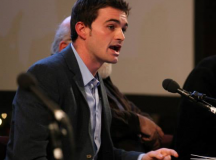Jack Omer-Jackaman is the author of Caught Somewhere Between Zion and Galut: Israel, Zionism and Anglo-Jewish identity 1948-1982 (2017). In this lengthy and passionate Zionist critique he argues that Trump’s peace plan is duplicitous and self-interested in intent, irrational in execution, and will be dangerous and cruel in consequence for Palestinians and Israelis alike. For a radically different Zionist perspective, supportive of the Trump plan, see the arguments of Yossi Kupperwasser in this issue of Fathom.
Introduction
That the Trump plan itself is an affront to Palestinian national rights, to a just Zionism, and to diplomatic coherence is evident to anyone who has read it and is possessed of a commitment to the liberty and security of both peoples holding an interest in the land between the Jordan and the Mediterranean. Not much more opaque are the motivations of, respectively, the coterie around the President responsible for this travesty and the embattled Israeli Prime Minister who has so welcomed its announcement.
The plan’s ostensible architects are the lawyer and Trump loyalist Jason Greenblatt, the US Ambassador to David Friedman (whose Israeli allegiances can be said to fall squarely into the ultra-nationalist camp and who branded J-Street, the dovish American Zionist organisation, as being ‘worse than Kapos’) and Jared Kushner, the diplomatic dauphin. In pre-floating the plan, the authors made much of their desire both to break from the straitjacket of the traditional two-state solution and to convince both sides (but mostly the Palestinians) to forego unproductive obsessions with the past. One could, indeed, find some sympathy in this latter hope, provided the demand were made equally to Israelis as well as Palestinians. Focus on historical grievances does indeed act as a brake on the wheel of compromise and mutual recognition. Even if we were charitable enough to assume them in earnest, however, in seeking to apply such a proscription to the Israeli-Palestinian conflict, the deal-makers of the century have picked the wrong conflict. ‘The past is never dead’, wrote Faulkner: ‘it’s not even past’, a sentiment whose wisdom no other conflict better illustrates.
That they purport to wish to move on from a paradigm which, although it has underpinned American policy and its doomed attempts at peace-making for decades, has been regarded as passé for some time, also seems, on the surface, justifiable. Except that the plan itself remains firmly within the increasingly unpopular two-state paradigm, dispensing only with the traditional assumption that, while the parameters of a settlement are unlikely ever to be equitable, they should at least avoid being prohibitively iniquitous to the Palestinians.
Let us speak plainly: it is a plan to satisfy the most ambitious dreams of the Israeli ultra-right as well as the more deranged Rapture-fantasies of American Evangelicals, and one to which no self-respecting Palestinian leader could ever attach an imprimatur. Indeed, it is so far-fetched and egregiously one-sided that were its likely effects on an already tragic conflict not so dangerous, the plan would be satirically comic. Its central conceit is that, in common with all successful peace-making efforts, it calls upon both parties to make painful sacrifices, concessions and compromises. Close reading of the plan, however, reveals this apparently laudable premise to be mere bromidic sophistry. For, on all the points that matter, it is the Palestinians who are being asked (if one can use so neutral a word for a process with all the hallmarks of bribery and extortion) to concede and compromise. The only Israelis – or at least the only Israelis on whose opinion Bibi and Trump lend any weight – for whom the plan entails any sacrifice whatsoever are those on what we may have, in the sorry contemporary scene, to call the ultra-ultra-nationalist right, for whom Bibi is too soft and for whom only the total denial of Palestinian rights will suffice.
Part 1: The Palestinians and the Trump Plan
Before looking at the utter self-abasement it really demands of them, let us consider what the plan’s advance propaganda purported to promise the Palestinians: a path to statehood with a capital proximate to East Jerusalem, eventual international normalisation, and economic prosperity. When a people has been powerless for, by now, the entire lifetimes of many of even its oldest members, when it has for so long been denied sovereignty over any part of its civic heart of Jerusalem, and when its economic development has been stunted both by the occupation as well as the corruption and ineptitude of its leadership, then who could do else but rejoice at such a promise? Except, of course, that the plan offers nothing of the kind. It is the two-state solution applied not through the filter of the moderates on both sides, but through that of the Israeli maximalists.
Borders and Sovereignty
The Palestinians are offered ‘statehood’ in an expanded Gaza area: the current Hamas-held territory supplemented by two remote and hitherto unimagined portions of the Western Negev – one pre-designated for high-tech industry and the other for residential development – the whole thing connected by the thinnest of joins. This enclave is to be rendered contiguous, via an underground tunnel, with a cantonised West Bank shorn of the entire Jordan Valley and areas of contiguous Israeli settlement which are to be legally, and thus respectably, annexed to the State of Israel. The contiguity provided for this rump West Bank, cleaved in three as it is by settlement clusters, is only by road. Thus, to the delight of ironists everywhere, the ‘Deal of the Century’ (the designation, remember, implied generosity to the Palestinians) offers the Palestinians, in its munificence, roughly 75 per cent of the West Bank compared with the nearly 94 per cent offered personally by Ehud Olmert to Mahmoud Abbas in 2008 and the 94-96 per cent envisaged by the post-Camp David 2000 Clinton Parameters and subsequently agreed to by the Israelis at Taba in 2001.
The prescription for the Jordan Valley is both a radical departure from established norms and a green light for imminent Israeli annexation. Previous proposals have recognised both the rightful Palestinian claim to sovereignty in the valley and Israel’s quite legitimate designation of the area as crucial to its security. They have therefore included the area in a proposed Palestinian State with the proviso that Israel be permitted to retain early warning stations within it (three according to the Clinton Parameters). Gone is the logic which previous proposals shared with almost the entirety of international opinion and transnational jurisprudence: that UN Resolution 242 should be properly interpreted as demanding that Israel withdraw fully from all territory occupied in June 1967, and that a just solution involve only minor pragmatic adjustments to the ‘67 borders, with land swaps made to reflect the thorniest areas of settlement concentration and security consideration. The plan is quite explicit in its rejection of this interpretation of 242, arguing that Israel has already long-since complied with its terms in trading land for peace with Egypt in the Sinai and in its unilateral withdrawal from Gaza. It also reasserts the hoary cliché that the defensive nature of Israel’s victory in the Six Day War means that a proper interpretation of international law requires of it no concession of territory in any case.
So much for the territory to be enjoyed by this dissected Palestinian statelet; what of its character and powers? We have, in the form of Trump-Kushner, the most ironic crusaders for global arms limitation imaginable, for the State of Palestine is to be one of those famous, so-much-wished-for, disarmed states. Nor is this state of impotence to be phased out once the Palestinians have lived up the plan’s many demands that they prove themselves worthy of ongoing ‘independence’. No, the disarmed status, it is clear, is to be permanent. The Palestinians are, furthermore, to achieve their longed-for normalisation by joining that long list of enviable sovereign nations lacking jurisdiction over both airspace and territorial waters. ‘Sovereignty’, the plan explains to the Palestinians with all the hauteur they have come to expect, ‘is an amorphous concept that has evolved over time … [t]he notion that sovereignty is a static and consistently defined term has been an unnecessary stumbling block in past negotiations.’
Freed from the bounds of historic and prevailing norms then, the new State of Palestine will not only not have to worry about, but is in fact disbarred from enabling, the defence and security of its own borders. These are to be the preserve of Israel. The Palestinians and their enviable new state are, however, to be endowed with the powers to control internal security, except of course over those Israeli settlements not sufficiently contiguous to be annexed to Israel which will therefore remain extant in the new State of Palestine, enjoying unlimited physical access to the Jewish State and under its protection. Indeed, even internal Palestinian authority over Palestinians will not be truly autonomous in the new state, since the plan affords the Americans and the Israelis a veto power. Deviate from their wishes even slightly and the plan makes clear that even internal security will be instantly returned to Israeli control, reassuringly via the use of ‘blimps, drones and similar aerial equipment’ where possible.
It would no doubt be argued by anti-Oslo Palestinians that this would really be no more than a continuation of the security arrangements brokered by Clinton and agreed to by Arafat, whereby an Israel quite understandably concerned about the Palestinian Authority’s ability to protect its citizens from the violence of rejectionist factions retained a cooperative interest in partially devolved internal security on the West Bank. Understandable the desire may be, and may remain, but it is what enabled Palestinian critics of the process to regard the collaboration as the Palestinian Authority signing up for vassalage. It is certainly not the stuff of genuine, independent state sovereignty. Theorists from Hobbes to Weber have recognised the monopoly of the legitimate use of force inside a state’s borders as being the very definition of sovereignty. Only the most loyal of propagandists would dare make a case for the enfeebled princedom envisaged by the plan being any such.
Linked to the question of security requirements are the demands made of Abbas’s Fatah faction, the US and Israelis publically preferred Palestinian ‘partner’. Were it to find Abbas or an alternative West Bank Palestinian leader debased, desperate or suicidal enough to endorse it, it explicitly demands that they succeed in supplanting Hamas in Gaza before collecting from the table any of the proffered crumbs. Much as we might celebrate the defeat of the ultra-repressive regime in Gaza, Fatah – with its sclerotic leadership and ever-diminishing credibility in the eyes of many weary Palestinians – was incapable of imposing control on the area during the bloody internecine power struggle with Hamas in 2005 and is still so now, even assuming that the covert assistance of the Israelis, Americans and others, enjoyed then, would be repeated.
The Catch-22, of which all involved are surely aware, is that any Palestinian figure with sufficiently revolutionary bona fides to unite the national movement would be vetoed outright by the Americans and Israelis. Nor would any such leader even come close to engagement with his deal. It is, I suppose, possible that the Americans have something as hair-brained in mind as a resuscitation of the macabre political career of Mohammed Dahlan, the exiled former Fatah strongman who still has his supporters in both Gaza and the West Bank. ‘Our boy’, as he was called by GW Bush, remains admired by the Americans, and it is possible that they think his combination of ruthlessness and ambition can effect a bloody unification. The support for the plan of his Emirati patrons is certainly telling. Thus far, however, it seems that mutual revulsion at the plan has in fact precipitated renewed efforts at cooperation between Fatah and Hamas. In public, at least, Abbas and Ismail Haniyeh, Chief of Hamas’s Political Bureau, are talking rapprochement.
The inability to defend their new state from external threats is to the Palestinians’ own benefit, it is explained, as though to a child slow on the uptake, since ‘every [other] country spends a very significant sum of money on its defense from external threats. The State of Palestine will not be burdened with such costs, because it will be shouldered by the State of Israel.’ The extent to which the plan assumes that Palestinian ambition and self-respect can be purchased on the cheap is quite breath taking. Indeed, Trump has made much of the economic component of the plan which, in fact, presaged the rest when it was announced to widespread indifference at a summit in Manama, Bahrain in June 2019. To listen to him is to learn that Trump comes bearing riches beyond the wildest dreams, to be enjoyed by every Palestinian man, woman and child. $50 billion over the course of ten years is the extent of the promised largesse. But there are mighty strings, too, attached to the bounty. If, for example, the will of the Palestinian people was for its ‘state’ to effect even something as mild as a social democratic economic model, then the plan makes clear that the money and investment would dry up. Instead, from its demands for a ‘pro-growth tax structure, and a low-tariff scheme’ it is tempting, with knowledge of the American form, to infer that the new Palestine must first submit to being the next go-to destination for vulture capitalists before aspiring to perhaps one day reach the heights of a Middle Eastern Turks and Caicos.
In dangling the carrot of economic enrichment for the very few, and in the wake of a year in which an already immiserated Palestinian economy was further weakened by the cancellation of American aid, the plan attempts a shameless bribery which does not even bother thinly to veil itself.
Refugees
The two issues which have most bedevilled previous proposals are Jerusalem and the Palestinian refugees of 1948 and their ‘Right of Return’. On the latter, the plan’s shortcomings must be partially mitigated by the recognition that the issue would test even the Wisdom of Solomon. One can acknowledge Israel’s creation as having a role in the creation of the Palestinian refugee tragedy whilst also recognising that no peace deal will ever be signed which allows for the return, en masse, of the surviving refugees and their descendants (now numbered in the several millions by UNRWA) to their ancestral homes. It simply will not happen, and a sense of the moral imperative must be tempered by a hard-headed appreciation of realpolitik by those genuinely interested in reaching a viable solution.
That the plan does not offer even a token recognition of the moral right of return is no surprise. But the Trump plan also seeks to limit the return of refugees to the new State of Palestine! For, after lionising the Kingdom of Jordan as being the only state which has dealt equitably and with compassion with its Palestinian refugee population, the plan notes that ‘many Palestinian refugees in the Middle East come from war torn countries, such as Syria and Lebanon that are extremely hostile toward the State of Israel’, and that ‘to address this concern, a committee of Israelis and Palestinians will be formed to address this issue and to resolve outstanding disputes over the entry in the State of Palestine of Palestinian refugees from any location.’ Thus, the sizeable Palestinian populations of both Syria and Lebanon will, after seven decades of dislocation, have their ‘return’ to the new State of Palestine dependent upon an as yet unspecified committee of Israelis and Palestinians which will presumably devise or, which is more likely, have thrust upon it some novel test to determine the applicant’s radicalism.
For those deemed unfit by the committee, one potential option is to remain in their country of current residence, though the plan is clear that those countries have the right to veto their refugee populations remaining in what have now, in many cases, been exilic family homes for decades. It will no doubt be balm to the spirit of the over-500,000 Palestinians resident in Syria that if the worst happens and the omnipotent committee deems them too big a risk for the State of Palestine, they can rely on the famed compassion and judgement of Assad and the Ba’athist regime in Damascus.
Nor does the incoherence stop here. No doubt mindful that the Clinton Parameters raised the prospect of refugee repatriation to a country that was neither Israel nor Palestine nor the refugees’ current country of residence (while offering no specifics), the plan offers a bold innovation: that 5,000 refugees a year (for a total not to exceed 50,000) be homed in those members states of the Organisation of Islamic Cooperation which, presumably enticed by financial or diplomatic inducement, are prepared to sign up to the scheme. Since it does not explicitly preclude any members of the OIC from signing up, we can only conclude that the Plan could conceivably allow for the unsuspecting Palestinian refugee to find themselves ushered in the direction of Chad or Mauritania; Albania perhaps, if the US is able to offer something sufficiently compelling to Tirana. The OIC has subsequently, and unsurprisingly, issued a collective rejection of the plan.
Jerusalem
On Jerusalem, the plan is staggeringly audacious in its one-sidedness, and one of its proposals so surreal that I cannot be the only reader who at first thought that it had been inserted by a disgruntled member of Kushner’s staff as an act of satiric sabotage. Again, in pedantic deference to the literalists among my readers, before looking at what is promised to the Palestinians by this ‘Deal of the Century’, it pays to recall what arrangements for Jerusalem have been (reluctantly) accepted by Israeli governments of the past twenty years.
At Taba in 2001, Barak’s delegation accepted in principle the suggestion of the Clinton Parameters that sovereignty in the Holy City be divided: that Israel would exercise sovereignty over Jewish neighbourhoods and a Palestinian state exercise the same over Palestinian, predominantly Eastern, neighbourhoods in which it could establish its capital of Al Quds. Sovereignty over the respective Holy Sites of the Old City was less clearly defined, though Israel accepted the principle that the Palestinian State should exercise sovereignty over the Haram al-Sharif. Olmert, in an account not contradicted by Abbas, claims in 2008 to have gone much further in his offer to the latter, suggesting his willingness not only to accede to Palestinian sovereignty in East Jerusalem but actually to surrender the Old City, and thus the Holy Sites, to international control.
The Trump-Kushner plan proposes that current de facto Israeli control over the entire city be replaced with legitimised, or de jure, Israeli sovereignty over an undivided Jerusalem, with the international community called upon to follow Trump’s lead and recognise the whole city as Israel’s capital. At the plan’s official announcement, alongside this guarantee, Trump offered the cognitively dissonant nugget that his plan also allowed for the Palestinians to claim part of East Jerusalem as their own sovereign capital. Netanyahu helpfully clarified that what his friend had meant was that they would be permitted to establish a national centre in Abu Dis, the down-at-heel village with a population in the low five figures which is currently – and would remain – separated from East Jerusalem by an Israeli security fence.
The resurrection of one of the more hair-brained and doomed relic-ideas of the Oslo process was given a new twist by Trump-Kushner, however. Mindful that the Palestinian yearning for sovereignty in some part of Al Quds is imperishable, the plan suggests a simple renaming: Abu Dis will be rechristened Al Quds; solvitur ambulando. If Tom Lehrer was premature in declaring that political satire became obsolete when Kissinger was awarded the Nobel Peace Prize in 1973 then this suggestion, offered in apparent earnest by the leader of the free world, has certainly rendered the superannuation complete now. By this point in the plan, indeed, the view through the looking glass has turned positively hallucinogenic.
We have, in short, a plan more than three years in the making, pursued at considerable expense and launched with characteristic levels of braggadocio which has precisely no chance of leading to a lasting peace. Which begs the question, was it designed to do so? The judicious application of Occam’s Razor points to the conclusion marked cui bono. In this case, who benefits is, in ascending order of advantage: Trump and his Administration; Bibi Netanyahu; the ultra-nationalist, expansionist-rejectionist camp in Israel of which Netanyahu is but one part.
Part 2: Trump, Netanyahu and the Trump Plan
For all that he professed – accurately, it turns out – the utmost sanguinity over the Democrats’ attempts to impeach him, there is no doubt that the hoopla surrounding this non-plan brought Trump some welcome distraction, as did the earlier killing of the unlamented General Suleimani. The dog was, indeed, wagged. Dogs plural, in fact, since the plan’s announcement certainly provided even more welcome relief from the far more serious (in having greater likelihood of leading to serious sanction) legal threats facing his great friend Netanyahu, whose rejectionist approach to the conflict he has adopted in toto and with whom he shares both a hard-line towards Iran and a genuine personal warmth. The opportunity to delight their Evangelical supporters, whose approach to the conflict is informed less by humanitarian or geopolitical concerns than by the Book of Revelations, was also impossible to turn down. So much for the Trumpists.
For Bibi the whole affair has been a triple win. Firstly, it brought distraction from, and possibly lessened the public appetite for, his impending prosecution. Secondly, such an obvious victory for the Israeli ultra-nationalist vision helped staunch the bleeding of his traditional support to his chief rival Kahol Lavan and its leader Benny Gantz. It may also have won Netanyahu some converts from the camps of both the ‘Kingmaker’ Avigdor Lieberman, and Defense Minister Naftali Bennett’s far-right alliance. The third ‘win’ for Bibi, unique in that it actually transcends self-interest, is the biggest of them all. It is that in shifting the axiomatic parameters of the two-state solution – in establishing new and hugely advantageous Israel default positions – the plan drives the final nail, for a generation at least, into the coffin of a genuine two-state solution. Bibi’s defenders point to his formal acceptance of the notion of Palestinian statehood in his famed Bar Ilan speech of 2009. As though his subsequent myriad efforts to ensure it slips further from the horizon don’t show that aberration to be what it was: a sop to a new Obama administration to which he was, then at least, still required to show at least lip service. But in every fibre of his being, Bibi holds that a genuine two-state solution would represent an existential threat to Israel. By guaranteeing a Palestinian rejection, the plan allows for the two-state solution to be dealt death by its thousandth cut and, better still, the narrative can be spun so that the offending knife is to be found in a recalcitrant Palestinian hand. It will be said that the Palestinians are simply doing as they have always done in spurning the hand offered in peace, unwilling to abandon both the course of violence and their old dream of the ultimate erasure of Israel.
Part 3: Israel and the Trump Plan
Why did previous Israeli leaders pursue a ‘land for peace’ policy? Not because they thought Israel’s security dilemmas had gone away. They knew they were what they had always been: profound and many. Though its doctrinaire enemies – usually of the left – like to portray its regional strength as hegemonic, the facts remain that the Jewish State resides in a tough neighbourhood and that, as the old Israeli maxim has it, it cannot afford to lose a single war, while its enemies need win only one. Its security obsessions, implicated as they unquestionably and inevitably are with the tragedies of Jewish history, are neither paranoid nor likely to diminish. For this reason there has never been a political divide over the question of Israel’s need for constant vigilance and the permanent projection of strength; there have been no true ‘doves’ in high Israeli Politics.
Those who have made concessions to Israel’s neighbours, or who have inched closest to accommodation with the Palestinians, have been hawks who have concluded – sometimes reluctantly – that Israel’s security is best served by trading land for peace. Only this way, they have reasoned, can previously inveterate enemies become neighbours with whom the Jewish State can live, albeit in a state of constant vigilance requiring the projection of strength. For the ‘peace hawks’ the value of the land conquered in 1967 lay neither in its biblical-historic significance nor in the physical distance it created between the Jewish State’s heartland and its enemies. Rather, it was valuable in its bargaining potentialities. It was the return of the Sinai which enabled the original Likudnik Menachem Begin to forge a peace with Egypt which has held for over forty years, and it was with the return of the Golan that Barak (at least professedly) proposed to purchase a détente with Assad’s Syria. Security, not bleeding hearts, has determined Israeli concession.
So it was with that supposed Lion of the Peace Camp, Yitzhak Rabin. Rabin the warrior, Rabin the ‘bone-crusher’ of the First Intifada, was no gentle saint and was, indeed, a reluctant convert to the cause of peace. When he did convert, he did so as a soldier and an Israeli patriot who had come to the Realist conclusion that the Jewish State and the safety of its people were best served by a physical uncoupling from the Palestinians. Recognising this is not to diminish Rabin. While his interests were Israeli, and though he remained suspicious of his PLO partners, I think he also recognised the moral degradation brought to Israel and its people by the occupation of another and wished to see a day when the guns might be silenced and the bloodshed cease. In attempting actually to lead his people where he thought they needed to go he was a martyr to a cause which in the context of our benighted age we might interpret as the most noble to which a politician can commit – that of appealing to the best and most intelligent in the populace and being fully prepared to suffer the scorn of the rest. Tragically, of course – for him and for so many others – Rabin was to suffer far worse than scorn.
Before the ascent of the religious expansionists, it used to be that the opponents of ‘land for peace’ – at least those who mattered politically – were those who believed that any peace traded in this way was illusory and that land exchanged for recognition of Israel and the cessation of hostilities was a Trojan Horse since ‘Arabs’ could not be trusted; could be relied upon, in fact, to seek the destruction of Israel. Yes, withdrawal from the Sinai brought a lasting peace with Egypt but retreat from Southern Lebanon and Gaza begat more Hezbollah rockets – and a bloody war in 2006 – and an enhanced ability for Hamas to assault the Israeli South.
A West Bank under Palestinian sovereignty would also bring calamity, says Netanyahu. His calculation is the opposite of that reached by Rabin, Barak and Olmert all of whom came to believe that occupied Palestinians were more dangerous than those with a defanged state. Netanyahu feels, genuinely I think, that his calling is to save the Jewish people not only from a nuclear-capable and genocidally intentioned Iran, but from the existential catastrophe of a genuinely sovereign Palestinian state. It is not a messianic vision but rather a particular conception of Israeli – and therefore Jewish – security that moves him. Amid all the talk of impending annexation, what is often lost is that Netanyahu would actually rather not pursue this course, preferring the status quo. He will, ultimately, be forced into acquiescence by the fact that he needs the annexationists’ support to govern. But the fact that he has demurred until after the election, despite the apparent American green light is telling.
Nonetheless, one can make this distinction between the motivations of Netanyahu and the zealots of the settler movement who are now so influential a political constituency whilst acknowledging that their aims converge. Whether in service to God’s Covenant or to Jabotinsky’s Iron Wall, both are committed to Jewish demographic, political and military dominance in what they are united in viewing as Judea and Samaria. Divergence on the question of formal annexation does not disguise the fact that both will continue to prevent the establishment of a viable Palestinian state in the West Bank. The combined ascent of religious manifest destiny and the fatalistic Netanyahu worldview have made the rejectionist camp utterly dominant in Israeli elections and, therefore, in Israeli decision making.
Part 4: The Region and the Trump Plan
To a large extent, the Trump plan’s intended audience was not in Ramallah but in Riyadh, in Doha and in Cairo. There, the administration expects realpolitik to trump concern for the popularity of the Palestinian cause on the famed ‘Arab Street’. There was a time when the Arab states and their umbrella organisations could be relied upon to champion the Palestinian cause in public, at least rhetorically. Today, as the plan makes explicit, the US is relying on their common enmity towards Iran and other areas of shared interest (not to mention a sense of quid pro quo for the blind eye turned to the Khashoggi killing and the brutal pounding of Yemen) to persuade several of the Sunni powers not only to forgive the ludicrousness of the plan, but to leverage pressure on their Palestinian ‘brothers’ for its acceptance.
In this, Trump was initially offered some encouragement. Bahrain, Oman and the UAE sent representatives to the announcement, offered supportive statements and can probably be relied upon to remain on board. The Saudis and Egyptians, whose reactions were both of considerably more geopolitical importance, proffered cordial but non-committal statements; neither deigned to send a representative to the announcement. Qatar, as well as being a no-show, also stressed its commitment to any solution being faithful to the 1967 borders, seeming to rule out its doing any heavy lifting. Worse still, Jordan – for whom the plan has serious implications and on whose cooperation it relies in many places – bitingly condemned it, as did, predictably, Netanyahu’s old foe Erdogan.
Part 5: Is the Two-State Solution Dead?
Even before this latest assault upon it, the Two-State solution was hardly in rude health. The collapse of political will; the decline in popular faith among two weary and battled-scarred peoples; the programme of house demolition and settlement construction; the continued terror attacks and rockets: all have combined to mean that in both academic and activist circles those of us who have clung doggedly to it have been ridiculed as antediluvian, irrationally wedded to an idea which has outlived its own usefulness and feasibility. We, in turn, have affably chided our more enlightened friends that their unitary ‘binational’ solution is really no solution at all. That expecting two peoples to live side by side who have now known over a century of mutual enmity and grievance would test the optimism even of a Pollyanna. That, in fact, even were the miracle to happen and a unitary arrangement be agreed requiring the dissolution both of Zionism and Palestinian nationalism, the resultant mess would guarantee only eventual and bloody civil war.
My view on the deficiencies of the binational argument have not altered. And yet, I am forced to ask myself if Netanyahu has won. At the very least I am forced to conclude that so deep has the rot of messianic expansion and rejectionist cynicism set in, and so much have they polluted the spirit of Rabinist pragmatism, that a veritable political revolution, a Zionist Spring in Israel, is needed to break the grip which the settlers and their fatalistic enabler exercise over the country.
If the two-state solution is indeed dead and not, as we hope, merely in an induced coma, then will its epitaph read ‘What Might Have Been?’ or ‘Doomed to Failure’? Its advocates must ask themselves how real have been its supposed ‘missed opportunities’. Put simply, how far apart were the parties’ visions of two states when at their nearest? How much credence is to be given to the Israeli argument – often supported by American brokers – that such efforts have foundered thanks to mulish Palestinian inflexibility? Ought posterity to condemn Arafat and Abbas for not seizing the opportunities they knew to be the best their benighted people could ever hope to receive? While we cannot know where winds the road not taken, I think the future historian will at least conclude that in rejecting Taba and Olmert’s offer the two men rejected proposals offered in at least reasonable faith and whose content was serious and which will never be bettered from a Palestinian point of view.
Their Western leftist allies are wont to portray the Palestinians either as incapable of error or else as passively inert non-agents to whom history has merely ‘happened’. Such a reading is both patronising and ahistorical. Palestinian terror played its part in subverting Oslo – as it was intended to do – just as surely as did the bullet of Yigal Amir and the incitement of Netanyahu and Sharon. It is hard, too, to blame Israelis alone for the decline in influence and popularity of the peace camp, when so many households can solemnly name you a friend or loved one slaughtered by suicide-murder during the Second Intifada. And one can make a reasoned case that neither Barak nor Olmert erred in believing that in their offers they had met the Palestinians, perhaps not as far as they deserved, but as far as Israeli political reality would safely allow them. It is possible – perhaps even likely – that the wreckers on both sides would have succeeded in fatally undermining any accord reached on the terms of Taba or Abbas-Olmert; but it would have been an endeavour worth pursuing.
In contrast to these Palestinian failures, the future chronicler will not devote a moment to questioning the quality of Palestinian leadership when they turn their attention to their rejection of the Trump plan. They will conclude, surely, that its architects came not to revive an ailing process but to deliver the coup de grace; not to bring peace to two peoples so deserving of it, but to sacrifice the cause of one to the altars of expansion, narrow domestic political agendas, Great Power geopolitics and the subverting of personal legal travails. It is a peace plan fit for our times: duplicitous and self-interested in intent, irrational in execution, dangerous and cruel in consequence.








































An astute analysis and critique of Trump’s plan. Actually, if the author would be honest no peace plan would ever work because the Palestinians confuse their need for peaceful coexistence with their delusion of sovereignty. Every individual is entitled to live in peace and govern their own lives. If ever there was a time when peace would settle over the Palestinians and Israelis it would have to be established upon justice. Unlike the author I do not believe that justice is the sum of the opinions of various UN bureaucrats or governments. It is not “transnational”. Justice remains the highest aspiration because it, like truth, is neither distilled from compromise nor decided upon by voting. It is “blind” because it is indifferent to sentiments and forged only by truth. It is not determined by competing “narratives” because history is not a tale. It is the only context within which we may understand ourselves. Until Jews and Arabs reach this inner light, conflict will remain intrinsic to the human condition whether on the intrapsychic or socio-economic plane.